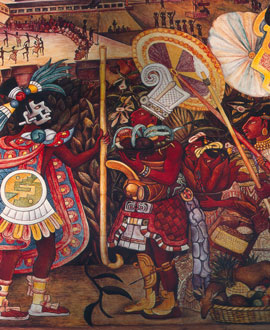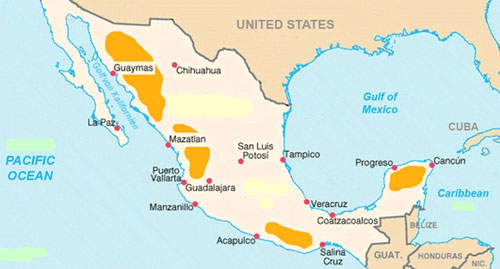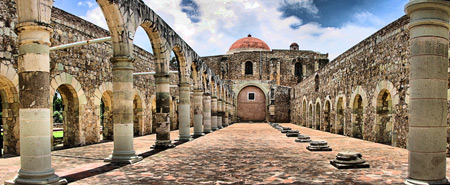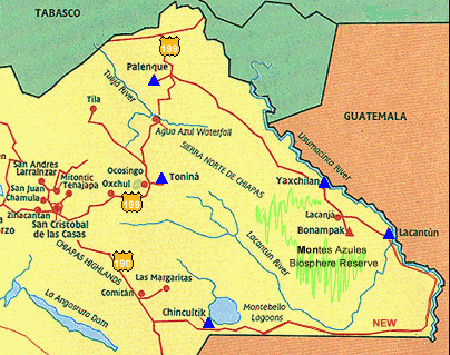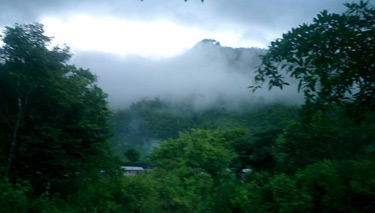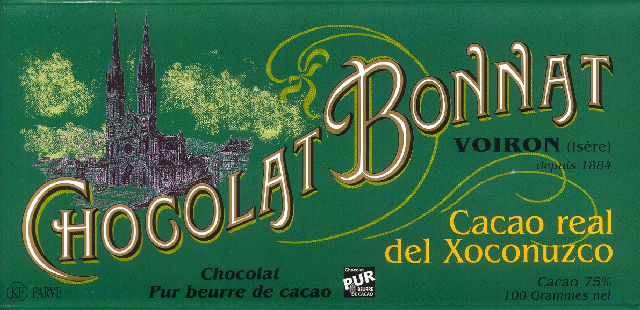FLAVOR PROFILE: Earthen (nuts, especially almonds), Spices & Herbs (licorice, clove, pepper); Fruit & Flowers (sometimes even Colombia-like marshmallow); light body; requires careful fermentation, processing & sugaring to mollify inherent acidity & bitterness.
CHARACTERISTICS: Criollo relics largely replaced by hybrids of Amazon Amelonado & Calabacillo lineage, notably the Matina type brought up from Costa Rica, assuming the name Ceylan. Plants from Ecuador were also introduced. In the 1970s the government promoted breeding programs that further eroded Criollo stocks… a generalized mole of a genetic mix known as ‘Injerto’, literally ‘grafts’ but more accurately ‘scions’.
Debatable cradle of cacáo; indisputable historical legacy.
Though history is rarely cut & dry, always prone to newer discoveries in the future that may supplant older ones, archaeo-botanical evidence at Paso de la Amada in Xoconochco (Soconusco) Mexico points to the Mokaya (“People of the Corn” ironically) among the 1st to cultivate cacáo in the Initial Formative Period during the Barra Phase (1800-1400 BC), this according to Professor Rosemary Joyce of UC Berkeley (Personal Communication, May 2009).
 Centuries later, traced thru a linguistic thread within the Mije-Sokean language family, the advanced terrace-building kingdom of the Yucatán Olmecas turned the pulp of the pod into a liquor, & prepared libations with it 3,000 years ago at La Venta. They were famed for colossal stone-head carvings & baby-face figurines, identified as the formative primogenitors of Mesoamerican civilization. Eventually the Mayans followed suit: cacáo depictions adorn their pottery used for chocolate drinking vessels in the ‘Classic Period’ dating to as early as 300 AD at Rio Azul (Guatemala; its Mayan name Sak Há Witznal meaning ‘Clear Water Mountain’). Fast-forward another thousand years, cacáo was a unifying force between geographically & linguistically diverse Mesoamerica (though not quite the cement that held it all together), whose reach extended close to the Panamanian isthmus all the way to Chaco Canyon, home to the Pueblo People known popularly as the Anasazi, in the current state of New Mexico USA. A tremendous area, over 2,000 miles, comprising a vast commercial emporium described by Prof. Steven Topik where silver, turquoise & critically salt from up north; gold, copper, & obsidian from down south; plus jaguar pelts, honey, rubber, seashells & tortoiseshell spoons from the coasts traveled to the central capital to be traded for ceramics, textiles & featherworks, including the spectacular Scarlet Macaw.
Centuries later, traced thru a linguistic thread within the Mije-Sokean language family, the advanced terrace-building kingdom of the Yucatán Olmecas turned the pulp of the pod into a liquor, & prepared libations with it 3,000 years ago at La Venta. They were famed for colossal stone-head carvings & baby-face figurines, identified as the formative primogenitors of Mesoamerican civilization. Eventually the Mayans followed suit: cacáo depictions adorn their pottery used for chocolate drinking vessels in the ‘Classic Period’ dating to as early as 300 AD at Rio Azul (Guatemala; its Mayan name Sak Há Witznal meaning ‘Clear Water Mountain’). Fast-forward another thousand years, cacáo was a unifying force between geographically & linguistically diverse Mesoamerica (though not quite the cement that held it all together), whose reach extended close to the Panamanian isthmus all the way to Chaco Canyon, home to the Pueblo People known popularly as the Anasazi, in the current state of New Mexico USA. A tremendous area, over 2,000 miles, comprising a vast commercial emporium described by Prof. Steven Topik where silver, turquoise & critically salt from up north; gold, copper, & obsidian from down south; plus jaguar pelts, honey, rubber, seashells & tortoiseshell spoons from the coasts traveled to the central capital to be traded for ceramics, textiles & featherworks, including the spectacular Scarlet Macaw.
Amazingly, with the exception of tiny Cozumel island, the entire network operated with little coastal traffic or even much in the way of rivers because there are so few of them to tie together the far-flung populous. Nor were there any beasts of burden, or wheeled vehicles to carry the load. Steamships & the railroad were still centuries away from re-routing world geography, setting in motion a revolution in space, time, & trade. Instead, goods went overland on the backs of humans walking up & down the high-valleys deep inside the continent where people lived, separated by ruggedly precipitous ravines & mountain ranges scaling 12,000 feet, along steep slippery paths, some cut into crags, others crossing rope bridges to ford gorges where one misstep meant death. These couriers, called the pochteca, the FedEx of their day (when it absolutely positively had to be there), constituted an elite professional class specializing in commerce. They were granted privileges & exemptions including their own residential island of Tlateloco, for supplying market squares & enormous arcades that stunned foreigners. Tlateloco to the capital Tenochtitlán approximated the modern distinction between the official business of Washington DC versus the emporium & club culture inside Manhattan. Every bit the match & more for Gotham, it rolled with ravers deep past the night, singing & dancing well into sunrise, fueled by tobacco blunts, psilosybin mushrooms & goblets of cacáo.
Bernal Díaz del Castillo, a medieval Herodotus, wrote the monumental True History of the Conquest of New Spain, his eyewitness account about the very moment when the Old World met the New: “we went there to serve God & to get rich”. He went there as a Conquistadore-turned-chronicler. Fortunately for him the loot was incalculable. In the tiyanquiztli (marketplace) “we were astounded at the great number of people & quantities of merchandise, & at the orderliness & good arrangements that prevailed, for we had never seen such a thing before”… all at an exchange rate that appeared to be highly favorable to the Europeans: another Conquistadore, Juan de Grijalva, excited over gold, pearls & cacáo for 3 combs & a mirror. From the vendor’s view, he gave up just raw base materials. In his eyes, for instance, gold’s intrinsic value paled compared to its functionality in jewelry, crafts & art.
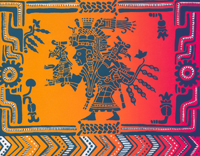 Díaz personally knew the principle figures, from Cortés & Hernandez to the Mexìcâ (Aztec) Emperor himself. He witnessed a Mexìcâ culture that put cacáo near the very center of its state ideology, exacting it as tribute for battlefield victories & alliance obligations after warriors drank it to steel themselves during combat, & a K’iche’ Mayan cosmology whose genesis myth from their sacred text, the Popol Vuh, sees in cacáo a precious elixir released from Paxil (‘Sustenence Mountain’) on which humans were first created & raised, placing it right between the ‘wild’ & ‘civilized’ spaces represented by Theobroma bicolor & maize respectively, in which a sip of chocolate became a sacramental act, & its sacred use to anoint children in a water-ceremony (a kind of baptismal ritual still in practice today called ki’n ha’); betrothal & marriage ceremonies (a dowry from the groom’s family to the bride’s); fertility & female imagery (cacáo’s oval-shaped fruit with longitudinal creases, some bearing red pigment, recall the vulva, plus its white interior pulp & the manner it hangs from the tree is suggestive of breasts); sexuality (the very act of preparing cacáo, almost invariably by women, was a social performance mimicking intercourse: pouring it from a height well off the ground to create a foamy beverage represented the phallus & the ensuing froth equaled orgasm, a sacred transformation parallel to floods of destruction & creation); royal lineage & mortuary offerings (to worship ancestors who sowed the first seeds in the world, illustrated on King Pakal’s sarcophagus at Palenque where his mother Queen Zac K’uk’ is depicted thru a cacáo tree); divination rites (during which the tlicitl or shaman clusters cacáo seeds in prime numbers of 1, 5, 7, 9, & 13); or embolden victims of human sacrificial rites because it was thought of as the bleeding of the Earth & an oblation made from cacáo pods & seeds (called puyulcha, literally “sacrifice”) symbolized the human heart & blood – fluid & coursing with a life-infusing elixir. Eerily similar to the Christian Eucharist & the liturgy of that sacrifice. Indeed, during the 1500s chocolate infiltrated the Mass when Friar Toribio de Benavente (”Motolinia” or the Humble One) consecrated it the ultimate comfort food to replace wine for euphoric communicants.
Díaz personally knew the principle figures, from Cortés & Hernandez to the Mexìcâ (Aztec) Emperor himself. He witnessed a Mexìcâ culture that put cacáo near the very center of its state ideology, exacting it as tribute for battlefield victories & alliance obligations after warriors drank it to steel themselves during combat, & a K’iche’ Mayan cosmology whose genesis myth from their sacred text, the Popol Vuh, sees in cacáo a precious elixir released from Paxil (‘Sustenence Mountain’) on which humans were first created & raised, placing it right between the ‘wild’ & ‘civilized’ spaces represented by Theobroma bicolor & maize respectively, in which a sip of chocolate became a sacramental act, & its sacred use to anoint children in a water-ceremony (a kind of baptismal ritual still in practice today called ki’n ha’); betrothal & marriage ceremonies (a dowry from the groom’s family to the bride’s); fertility & female imagery (cacáo’s oval-shaped fruit with longitudinal creases, some bearing red pigment, recall the vulva, plus its white interior pulp & the manner it hangs from the tree is suggestive of breasts); sexuality (the very act of preparing cacáo, almost invariably by women, was a social performance mimicking intercourse: pouring it from a height well off the ground to create a foamy beverage represented the phallus & the ensuing froth equaled orgasm, a sacred transformation parallel to floods of destruction & creation); royal lineage & mortuary offerings (to worship ancestors who sowed the first seeds in the world, illustrated on King Pakal’s sarcophagus at Palenque where his mother Queen Zac K’uk’ is depicted thru a cacáo tree); divination rites (during which the tlicitl or shaman clusters cacáo seeds in prime numbers of 1, 5, 7, 9, & 13); or embolden victims of human sacrificial rites because it was thought of as the bleeding of the Earth & an oblation made from cacáo pods & seeds (called puyulcha, literally “sacrifice”) symbolized the human heart & blood – fluid & coursing with a life-infusing elixir. Eerily similar to the Christian Eucharist & the liturgy of that sacrifice. Indeed, during the 1500s chocolate infiltrated the Mass when Friar Toribio de Benavente (”Motolinia” or the Humble One) consecrated it the ultimate comfort food to replace wine for euphoric communicants.
Chocolate held such revered status that it presented the perfect foil for poison. Mesoamericans concocted turkey wattle served to unsuspecting victims. And the Spanish ladies of Chiapas doctored it to murder their bishop.
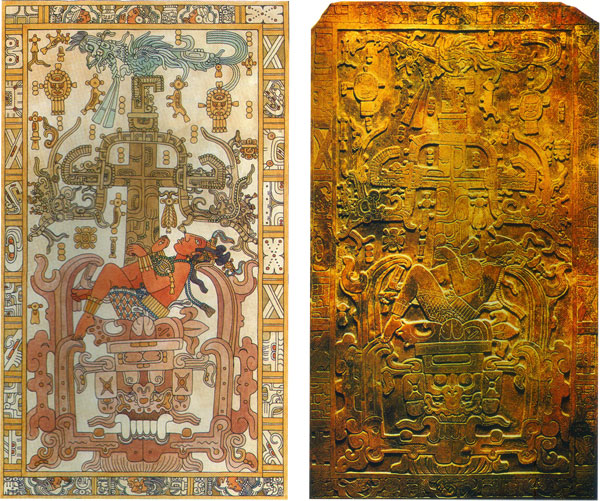 (Above) Mayan Wayob (Cosmic Dreaming) or merely an Ancient Astronaut? The lid of Pakal’s sarcophagus (color reproduction on the left; original on the right) depicts him reposed in the doorway of death on top the earth water monster. Below him the open jaws of a jaguar symbolize his descent into the maws of Xibalba, the Mayan underworld. Above the Celestial Bird (Vucub-Caquix?) horizontally perched atop the Cosmic World Tree / Axis Mundi (the 4-directional cross yax imix che) which, in turn, holds a becephalous Vision Serpent in its branches guiding Pakal’s voyage across the liminal zones: the heavens above & the underworld below / the physical universe & the spirit realm of ancestors. An alien view fascinated upon by astro-theororists sees in it evidence of celestial visitation & mythological intelligence with Pakal a time-traveler from the future at the controls of a rocket ship complete with respiratory mask, foot pedals & an exhaust engine worthy of von Däniken’s Chariot of the Gods launching for a wormhole… a blastoff whose very decibels composed the Baroque “Pakalbel’s” Canon!
(Above) Mayan Wayob (Cosmic Dreaming) or merely an Ancient Astronaut? The lid of Pakal’s sarcophagus (color reproduction on the left; original on the right) depicts him reposed in the doorway of death on top the earth water monster. Below him the open jaws of a jaguar symbolize his descent into the maws of Xibalba, the Mayan underworld. Above the Celestial Bird (Vucub-Caquix?) horizontally perched atop the Cosmic World Tree / Axis Mundi (the 4-directional cross yax imix che) which, in turn, holds a becephalous Vision Serpent in its branches guiding Pakal’s voyage across the liminal zones: the heavens above & the underworld below / the physical universe & the spirit realm of ancestors. An alien view fascinated upon by astro-theororists sees in it evidence of celestial visitation & mythological intelligence with Pakal a time-traveler from the future at the controls of a rocket ship complete with respiratory mask, foot pedals & an exhaust engine worthy of von Däniken’s Chariot of the Gods launching for a wormhole… a blastoff whose very decibels composed the Baroque “Pakalbel’s” Canon!
(Below) Bas-relief of Queen Zac K’uk’ reborn via a cacáo tree on the North End of her son King Pakal’s sarcophagus (left); mirror image (right) drawn by Merle Greene Robertson
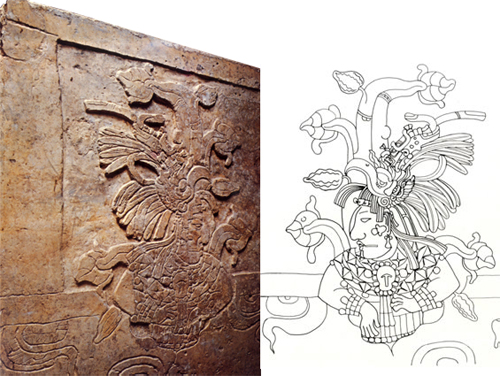
Dissertations have been written, most notably by University of London pharmacists Johanna Kufer & Michael Heinrich, on the structuring of the universe in complementary paired opposites as the central principle underlying Mesoamerican cosmology. In that dualistic universe, cacáo & maize symbolically mirror & mutually depend on each other from opposite ends of the spectrum. Their multivalent properties include –
— Color: Black & White… white maize is considered the most sanctimonious, as is the darkest, almost-black cacáo;
— Directional Movement: both are referred to in Spanish as mazorcas (‘cobs’ in English) but corn grows upward with its grains on the outside of the cob while cacáo hangs down & its seeds are embedded inside a pod;
— Sun vs. Shade: maize thrives in sunshine; cacáo in shadowy forests;
— Gender Associations: cacáo is generally viewed with the feminine, identified with darkness, night, the earth & moon, & female deities covering springs & waterholes as well as the wet seasons of the year; maize on the other hand relates to the sun, daylight, sky, & male rain gods.
Taken together, this reverence & value that Mesoamericans attached to cacáo help explain why it eventually became their currency.
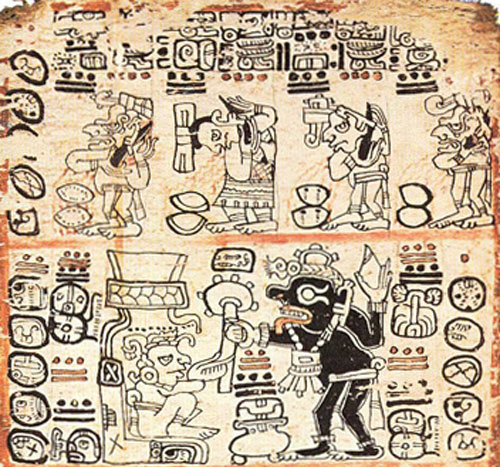
Ek’ Chuwah, the god associated with travel, trade, & cacáo merchants, cavorting with the maize god while 4 supernaturals above cut their ears to give blood to cacáo pods (from the Madrid Codex)
The traditional importance of cacáo is difficult to exaggerate for reasons of physiology as much as cosmology. It was one of the few stimulants widely available in Mesoamerica (leaving aside hallucinogenic plants – peyote, psilocybin, datura, & morning glories), unlike South Americans who had easy access to a greater array of options from yerba mate to guaraná & coca (cocaine). Mayans so revered it that in the Yucatán, where scant rainfall & poor soil make growing it nearly impossible, they developed complex silviculture, setting cacáo trees in soil-rich sinkholes called aguadas & subterranean cenoté pools that form when mildly acidic rain falls on the karst topography & seeps in to dissolve the limestone, creating damp caves. Bishop Landa described these micro-environments as “sacred groves” because the Maya considered them real-world portals / pathways known as sacbes (meaning ‘white roads’) into the center of the Earth that pass through the “Jaws of the Underworld” (to the lords of Xibalbá, with Hun-Came the most pre-eminent), a spirit highway via which the dead would travel in a larger saga of death & rebirth, further reinforcing cacáo’s symbolic associations with darkness, moisture, & the feminine. Some of these were located nearby to where Cortés initially made landfall at Vera Cruz before his storied march on the flourishing Mexìcâ (Aztec) capital at Tenochtitlán, the advanced municipality & largest city in the Americas, which conquistadores marveled was of unimagined landscaping & civil engineering, as large & grand as Europe’s finest at the time – Paris, Venice, & Constantinople.Diaz recounted: And when we saw it built on the water from that straight & level causeway leading in, we were astounded…buildings rising from the water, all made of stone, seemed an enchanted vision…Our soldiers asked whether it was not all a dream… too wonderful that I don’t know how to describe this first glimpse of things never heard, seen, or dreamed before.
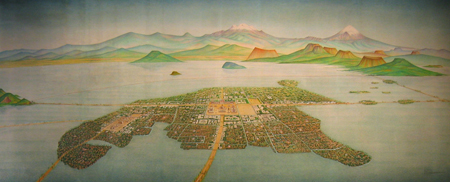
Tenochtitlán – city plan (above); sacred plaza (below)

Constructed on an island in Lake Texcoco, upwards of a quarter million enjoyed the city’s unique system of lake agriculture known as chinampas, interlaced with tlaxilcalli (streets wide enough for 10 horses) & canals so that all sections of the city could be traversed either on foot or via canoe. As Diaz further noted, Tenochtitlán connected to the mainland by causeways leading north, south, & west that were interspersed with bridges for canoes to pass freely. These bridges could be pulled away if necessary to defend a city where universal education was the rule, where citizens bathed twice a day (in the Emperor’s 100 room palace, each had a bath), & ladies-of-the-night came free of charge. And at the center stood the sacred precinct, including the Huey Teocalli (Great Temple) pyramid to the Mexìcâ gods Tlaloc & Huitzilopochtli. At the base was the Hueyi Tzompantli (an abacas of a skull-rack) holding 60,000+ heads decapitated during mortuary rituals.
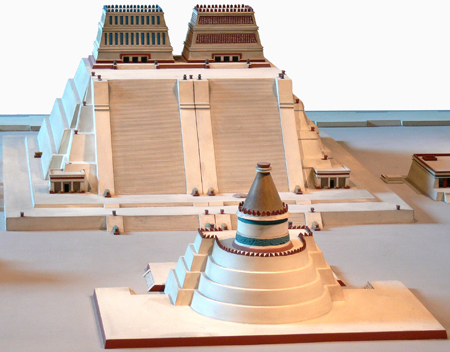
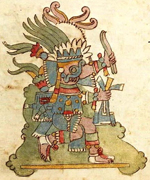
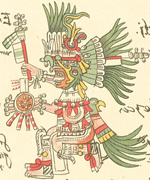 Close-up of the twin temples atop the Huey Teocalli (Great Temple) Pyramid (above). One dedicated to the rain god Tlaloc (left; image from Codex Rios); the other to Huitzilopochtli, god of war (right; image Codex Telleriano-Remensis). Approximately 30 meters / 90 feet in height, plus braziers in which sacred fires burned continuously. Balustrades flanked each stairway taken only by priests & sacrificial victims that terminated in menacing serpent heads at the base. It is thought that during the equinox, the sun rose between the shrines & shone directly on another temple (in the immediate foreground) to the plumed serpent god Quetzalcoatl.
Close-up of the twin temples atop the Huey Teocalli (Great Temple) Pyramid (above). One dedicated to the rain god Tlaloc (left; image from Codex Rios); the other to Huitzilopochtli, god of war (right; image Codex Telleriano-Remensis). Approximately 30 meters / 90 feet in height, plus braziers in which sacred fires burned continuously. Balustrades flanked each stairway taken only by priests & sacrificial victims that terminated in menacing serpent heads at the base. It is thought that during the equinox, the sun rose between the shrines & shone directly on another temple (in the immediate foreground) to the plumed serpent god Quetzalcoatl.
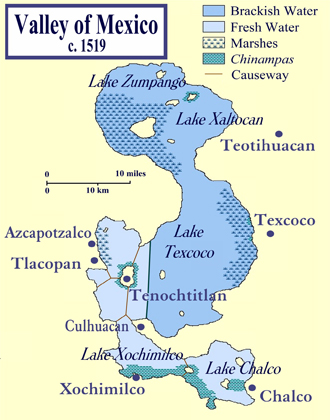
Along one of those causeways on November 8, 1519, Cortés met Motecuhzoma Xocoyotzin (Moctezuma II; the Emperor addressed in his own culture as Tlatoani for ‘great one who speaks’), when two worlds collided after the men toasted each other with a frothy ceremonial draft of… one would imagine… cacáo, for customary protocol at the Mexìcâ court called for royal fanfare to welcome dignitaries with water for washing hands, a goblet of cacáo for settinggood mood & conversation, the relaxing effects of tobacco tubes as a sign of friendship which Einstein would later observe contributes to “objective judgement in all human affairs”. Plus, uplifting flowers.
This summit triggered the Colombian Exchange, coined by Alfred Crosby, in which the East & West hemispheres would eventually trade everything from crops, animals, manufactured goods, disease, ideas, & culture. Any hoped-for friendship lasted less than 8 months with an empire practically demoralized in a single night – La Noche Triste – on July 1, 1520, a ferocious all-night battle which forced Cortés’ withdrawal from the city, only to return the next summer to demolish it for good during the same season that the Edict of Worms declared Martin Luther an outlaw & a heretic back in Europe, unleashing the Counter-Reformation – the Church’s response to his heresy that would also impact aboriginal Americans a world away.
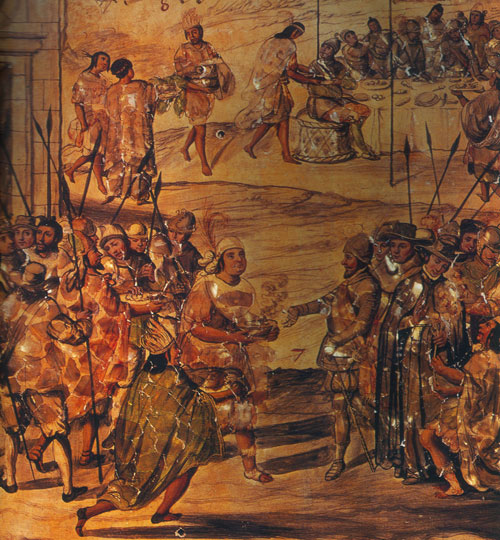
(above) Miguel González’ rendition of Cortés meeting Motecuhzoma (painted in 1698); (below) Monument commemorating the event along the causeway on which it took place in present-day Mexico City
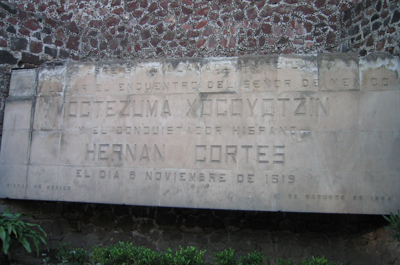
Exotic & foreign on the one hand (the naturally naked standing toe-to-toe with the coarsely clothed; those with war paint face-to-face with those who wore beards; people living within the rhythms of the Earth versus the techno-bent who believed in domain over it), while on the other their summit was hardly strange at all, especially from the vantage point of the Spanish conquistadores, if only for the reason that current world literature & scholarship knows more about the European than the Mesoamerican experience.
Whatever the Spaniards failed to grasp linguistically during the initial encounter due to language barriers (which they rapidly overcame starting with translators La Malinche/La Chingada, a young enslaved native woman, & Fr. Gerónimo de Aguilar who learned Mayan in captivity prior to Cortés’ march) they compensated for with an intuitive knowledge honed in their own earlier epic of the brutal Reconquista (Reconquest) against a tribally fragmenting Islam, a Zeno-worthy conquest of a thousand battles, sieges & twisted protection plots that led to the rise & fall of the Muslim Caliphate at al-Andalus on their own soil back home over the course of 3 centuries, which served as a dress rehearsal of sorts for this momentous event. The Codex Mendoza, a near-contemporaneous history, most likely commissioned by the eponymous Antonio de Mendoza – the first viceroy of New Spain — is a prime example of “auto-ethnography” with images by indigene scribes, of colonial collaborators (Spanish annotation), for the benefit of outsiders. It uses the term mezquita (Spanish for ‘mosque’) to describe Aztec teocallis (temples), so demonstrating the degree to which Spaniards viewed their encounters with Amerinds within a framework shaped by their prior one with the Arab world. That is, once Ferdinand & Isabel got around to giving Cristobal Colón (Columbus) the monies needed for his three ships on their wild overseas venture in the same year (1492) that they also vanquished the Moorish kingdom of Granada & took possession of the legendary Alhambra palaces & gardens, thus ending almost 800 years of Muslim rule on the Iberian peninsula. (Catholic Kings also expelled Sephardic Jews from Spain in that year for good measure.) All the revolutionary energies that fueled the liberation of the newly united kingdoms at Castilla & Aragon, now fused together as a triumphant new nation-state known as España (Spain), & were freed up from the task of getting rid of the hated Saracens (Muslims) from their fanatically Catholic lands, & so driven by crusading zeal & conviction in providential destiny had only one place to go… Orbe Novo / El Mundo Nuevo.
The equivalent of our ‘go West, young man’ & apt parallels between America’s post-WWII experience. Particularly a young bold & fresh leader challenging a nation “before this decade is out”… we went to the moon; they came to the New World.
Indeed, the settlement process & policies that led to Spain colonizing the Americas originated in the Reconquista. Specifically, the Capitulación: a formalized ordinance used to full effect in organizing whole continents based on land grants to conquistadores for territory they conquered, & privileges to suit (titled positions such as Gobernador or Capitan General).
Picking up & deciphering gestures, psychic cues, & semiotic signals became part of the Spanish conquerors’ socio-political DNA enabling them to negotiate across cultures, vividly embodied in the legend of La Malinche, whose upbringing is thought to be that of a noble, trained for Amerindian court life. If true, Cortés may very well have sensed that her loyalty would be expected thru a marriage alliance between elite classes, even one as foreign as his; that her primary allegiance would be to assist her husband achieve his military & diplomatic objectives.
In many respects the Spanish were indeed the most sensuous of European colonizers, accepting of & to a large degree wedded to miscegenation, quite unlike the Dutch, English & French, at least during the latter stages of their colonial adventures when they became Social Darwinists in their sexual appetites. (Indeed, the great-grandson of Moctezuma II, Pedro Tesifón, was titled Count Moctezuma de Tultengo in 1627 to become part of Spanish nobility.)
So naturally, Cortés ‘goes native’… & had an affair with her & a son too (Don Martin Cortés – “El Mestizo”, the first known Mestizaje, mixing Amerinds with Europeans) before marrying her off to one of his officers, Juan Jaramillo.
The legend of Gonzalo Guerrero, the shipwrecked sailor whom earlier the Chactemàal Maya enslaved then rehabilitated into their own military captain, says he married a Mayan noble, Zazil Há, thought by most to be the parents to the very first Mestizaje children.
Whatever the precise circumstance, Mestizaje created the conditions for a form of colonization that eventually went both ways, with memes flying back & forth across the Atlantic as narrated by historian Marcy Norton in her book on chocolate – Sacred Gifts, Profane Pleasures.
**********
Though his name roughly translates into “young angry lord”, Motecuhzoma’s gentle nature failed to correspond to his grand moniker. Somewhat an effete, he was more a scholar than a warrior, drawn to the nature of botany for its beauty & medicinal benefits rather than to military affairs. He instituted, for instance, a royal botanical garden emulating the mythical lands of the gods at Huaxtepec in Morelos to clinically research plants. He also had an aquarium & two zoos at his palace in Tenochtitlán. These interests proved his undoing.
He honored his foreign guests with flowers from his own garden – the ultimate gesture for the Mexìcâ (Aztec) culture. According to the Franciscan missionary Bernardino de Sahagún (whose original brief was to distinguish between genuine converts to Christianity versus indigenes faking it to disguise their pagan substratum, but ended up launching field ethnography instead with his tome The General History of the Things of New Spain [The Florentine Codex]), Motecuhzoma showered the Spaniards with gifts, then more gifts – even gold – naively hoping it would send them away. A partial inventory of presents listed in the Carta de Veracruz received from him shows
2 collars of gold & precious stones;
100 oz. of gold ore that the Spanish Highnesses might see in what state the gold came from the mines;
2 birds of green thread & feather-work, with feet, beaks, & eyes of gold;
1 large wheel of pure silver; another of gold with figures of animals on it weighing 3,800 oz!;
1 fan of variegated feather-work splaying 37 rods embossed in gold plate;
16 shields of precious stones, with feathers of various colors hanging from their rims; 6 other shields, each covered in gold plate with what resembles a golden miter in the center.
Much as this went on to be smelted which, for the Aztecs, was incomprehensible. The thought of destroying precious crafts & arts to melt them down for their baser metal – even gold or silver – would be tantamount to scraping the canvas of the Mona Lisa for its paint. It just wasn’t the done thing.
Their appetites whetted, Cortés, the craftier Spanish leader, just 34 years of age, possessed an avaricious one of limitless proportions. He was a run-a-wreck, a renegade captain violating orders of his commission established back in Cuba by then-governor Diego Velásquez. Intuitively & then some he sensed in Motecuhzoma, 55, the opposite of his own greedy nature, & devoured him like vulnerable prey. In a little understood drama, the guest somehow took the host hostage. Within weeks, Moctezuma became a prisoner in his own palace & placed under house arrest by Cortés.
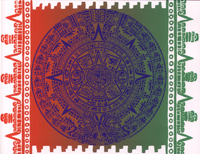 Cortés seemingly benefited by having arrived, according to Sahagún, at the right propitious moment. Beneath the glibly interpreted accounts of the Emperor taking 50 golden goblets of cacáo to fortify himself for a hard night in the harem (if so, he’d be in the bathroom all night instead of bed), Motecuhzoma had been studiously reading signs & omens. A string of events unfolded into a confabulation of woes: a comet had recently appeared during daylight hours; Tenochtitlán flooded; the Huey Teocalli (Great Temple) to the god of gods caught fire (an occurrence that was tantamount to the end of the world in Mexìcâ (Aztec) mythology, for unless the gods, having sacrificed themselves to create the world, could be propitiated with a fungible payment-in-kind via sacrificial rites or offered the sacred substance of precious blood that could breakthrough the celestial barriers, the solar orb would extinguish, a critical fact as Sophie Coe writes, that formed their raison d’être of self-sacrifice – not blood lust, cruelty, nor a death wish per se, even granting that the Mexìcâ (Aztecs) were a highly militaristic-warrior society in which upward mobility occurred only thru aggressive warfare but “a fear lest the world & the life on it should perish”… so they kindled fire to keep it going; no excuse, just an explanation.
Cortés seemingly benefited by having arrived, according to Sahagún, at the right propitious moment. Beneath the glibly interpreted accounts of the Emperor taking 50 golden goblets of cacáo to fortify himself for a hard night in the harem (if so, he’d be in the bathroom all night instead of bed), Motecuhzoma had been studiously reading signs & omens. A string of events unfolded into a confabulation of woes: a comet had recently appeared during daylight hours; Tenochtitlán flooded; the Huey Teocalli (Great Temple) to the god of gods caught fire (an occurrence that was tantamount to the end of the world in Mexìcâ (Aztec) mythology, for unless the gods, having sacrificed themselves to create the world, could be propitiated with a fungible payment-in-kind via sacrificial rites or offered the sacred substance of precious blood that could breakthrough the celestial barriers, the solar orb would extinguish, a critical fact as Sophie Coe writes, that formed their raison d’être of self-sacrifice – not blood lust, cruelty, nor a death wish per se, even granting that the Mexìcâ (Aztecs) were a highly militaristic-warrior society in which upward mobility occurred only thru aggressive warfare but “a fear lest the world & the life on it should perish”… so they kindled fire to keep it going; no excuse, just an explanation.
Admittedly, the gods must’ve been terribly thirsty for blood.
Blood, & by extension the still-beating heart, renewed a connection with the sacred that seemed essential to the very existence of the natural order. Rubbing sacrificial blood on idols ensouled them to operate in a literal transubstantiation, rather than symbolic transformation, on which the fate of the world & its inhabitants depended. In the K’iche’ epic Popul Vuh, after the first people were created, they gathered at Tollan, a mythical Place of 7 Caves, to receive their language & gods. There the K’iche’ accepted a Holy Trinity (Awilix, Jacawitz & Tohil). Tohil (aka God K; forerunner to the Aztec’s Quetzalcoatl) then demanded blood sacrifice of them, likening blood consumption to the suckling of an infant by its mother. So the K’iche’ offered their own as well as that of POWs captured in battle. That fulfilled the covenant just as the blood of Christ’s crucifixion formed a ‘New Covenant’ for Christians. Both archaic acts should be viewed within this framework.
The counter-story that brushes aside any excess of PC cultural-relativism: dedication for the 6th temple expansion in 1487 witnessed a procession of 20,000 or more bleeding souls, ordered by Emperor Ahuizotl marched up the towering pyramid rising from the valley & silhouetted by the mountains beyond, its steep balustrades flanked with menacing serpents to the grand platform, atop which ‘priests plunged obsidian knives decorated with eyes & teeth called “face blades” into prone victims, ripped them out to slit their throats, then reached back in to sever still-beating hearts that would be retrieved & held aloft, offered up in the braziers burning the sacred fire as if with so much hot chili sauce’. By the end, a river of blood ran down the steps to bathe the plaza below thicker than a slaughter-house. For war captives the ordeal went furthermore: decapitated, then limbs chopped off &, finally, body parts cast from the temple chambers to lie, perhaps, on the Coyolxauhqui stone — the daughter of Earth mother Coatlicue – herself dismembered by her offspring, the war-god Huitzilpochtli.
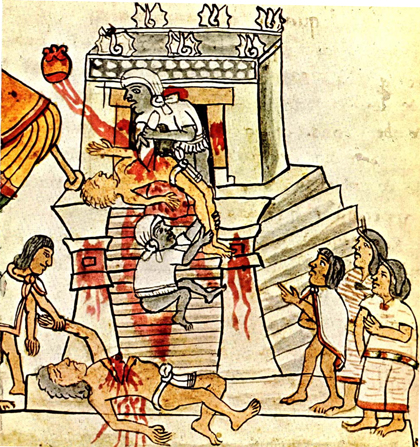 Human or inhumane sacrifice? Suffering a massive heart attack on the temple’s throbbing steps of doom. (From the Codex Magliabechian, 16th century)
Human or inhumane sacrifice? Suffering a massive heart attack on the temple’s throbbing steps of doom. (From the Codex Magliabechian, 16th century)
Most ominously, centuries earlier the prophet Huemac predicted the coming of the plumed-serpent Quetzalcoatl on 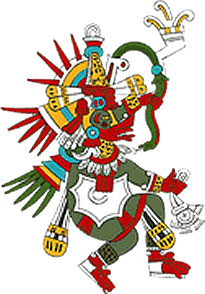 the very date Cortés came ashore. Whether true apotheosis or simply apocryphal, the narrative in the West has it that when Motecuhzoma’s emissary relayed the tale of this otherworldly white creature sailing in on a fleet of ships the size of floating cities, whom his hosts would present to the court dressed in feathers for the occasion, the Emperor was supposedly duped into believing Quetzalcoatl himself had arrived.
the very date Cortés came ashore. Whether true apotheosis or simply apocryphal, the narrative in the West has it that when Motecuhzoma’s emissary relayed the tale of this otherworldly white creature sailing in on a fleet of ships the size of floating cities, whom his hosts would present to the court dressed in feathers for the occasion, the Emperor was supposedly duped into believing Quetzalcoatl himself had arrived.
Ethno-historian Matthew Restall argues against this Quetzalcoatl-Cortés connection in 7 Myths of the Spanish Conquest. If the saga related to Gonzalo Guerrero holds true, he presumably told his Maya friends & family that Spaniards suffer death like other men. Upon meeting Cortés, Motecuhzoma reportedly lifted his shirt displaying the abdomen, saying, “I am mortal blood as you are mortal blood.” Countering his thesis, however, the Hopis of the American Southwest, thought to have had links with the Mexìcâ (Aztec) to their south (evidenced by the Hopi plumed-serpent named Awanyu), tell of a similar legend conflating the deity Pahana with a “lost white brother” who shall return, perhaps pointing to a common root of the Quetzalcoatl-Cortés connection.
This forms part of a wider, more trenchant revision of the Contact Period. The abridged version acknowledges that the Spanish Empire stood unique in its vast inland & maritime reach. It was driven by a combination of providential zeal on the part of the clergy trolling for souls, & racial animus from secular Conquistadors who fervently followed the literary ethos of the day – gallantry, valor, service to the crown… basically Don Quixote meets the modern comic book superhero in the way that, say, Hippies fell under the spell of the Beats, carrying Kerouac’s On the Road wherever they went, & listening to Ginsberg’s Howl while animated on LSD.
Whatever may be the ultimate verdict on ‘La Leyenda Negra y Blanco’ (the good vs. evil agenda of Spanish history), it’s indisputable that these men possessed wicked prowess reinforced by a broad cross-section of Iberian society: they rapidly swallowed up 2 of the most dynamic empires in the history of the world – Mexìcâ (Aztec) in Mesoamerica & Inca in South America. Most of the main characters whose storied careers would impact history during the next couple decades came over on the Transatlantic voyage under the command of Ovando in 1502, all part of a 30 ship / 2,500 person convey – the largest of its kind up ‘til then. All except the primary protagonist – Cortés – who literally missed the boat he was scheduled to be on because he was bedding down a woman just as the ships sailed off. Other than those types of happenstance, the Spanish enterprise in the Americas bears the foresight of a mission with a plan. Their eventual exploits were rather pre-designed, ruthlessly executed & thoroughly systemized. Right timing & good luck then made it all seem destined.
Several modern academics, including some native descendants among them, seek to lay waste to the Conquistador legends as mere fallacies concocted by Europeans, in a form of the oppressed rapping back. Their alternate history holds that the Mexìcâs were not susceptible to omens; that dressing guests in divine guises was a habit of hospitality; that the iconographic record depicts Motecuhzoma as aggressive & viral rather than some cowering effete (after all, he did expand the empire to its maximal size thru war); &, finally, his infamous speech in which he purportedly volunteers to hand over his throne to Cortés, abides by a native tradition of speaking diametrical to what one means or intends because politeness is the true form of dominance & superiority! Or just a form of diplomatic sarcasm?
Though this sounds ludicrous on the face of it, the field research of Virginia Davis in the 1970s for her dissertation studying Lacandon Maya may suggest otherwise: a practice of ‘reverse meanings’ that seems rooted in pre-Columbian traditions, in sacred contexts where objects/symbols reverse their meaning when moving between the polarity of earthly & ethereal planes. If true, this too would give weight to a possible Quetzalcoatl-Cortés identification.
Moreover, Quetzalcoatl is intertwined with a mytho-historicist figure Topiltzin Ce Acatl Quetzalcoatl (Our Prince One-Reed Feathered Serpent). Topiltzin supposedly emerged from Tollan in the west as leader of the Toltecs. He would some day return, the prophecy goes, from the opposite direction, after having been banished to Tlillan-Tlapallan in the east — where he transformed into the Morning Star (Venus) by burning himself. If nothing else, in tracing their lineage & basing their legitimacy on this figure, the Mexìcâ left themselves vulnerable in the eyes of those whom they subjugated. They spent a few centuries convincing subjects, allies, vassals, neighbors, sworn enemies – basically everybody – that they, the anointed Mexìcâ, were his almighty sole heirs. The whole machinery of human offerings, including child sacrifice, along with wars waged, was caught up in him. They made believers out of them… some die-hard, others of make-belief… just as in the USA Americans buy into the notion of ‘land of the free / home of the brave’ to varying degrees (occasionally dependent on the size of one’s bank or the hoped-for stake in the dream lottery). Just the perception of a challenge, let alone confirmation of one that succeeded, undermined the entire system for either would make the Mexìcâ dispensable. That conquistadores sailed in from the east, appeared white & looked exotically dressed (or at least unusual), fit the bill enough to expose the Mexìcâ as frauds. Therein lies a source of both insecurity & intimidation.
Leyenda Blanco scholars have their own revisionism on the fall of the Mexìcâs & Incas, discounting the importance of technology & disease, & contrary to the conventions of Guns, Germs & Steel by Jared Diamond. They reason that gunpowder alone would be insufficient to subdue a whole population enjoying the advantages of staggering numerical superiority. Indigenes were not the only ones, after all, vulnerable to foreign disease. Conquistadors were too, being completely alien to the territory, having to contend with even greater physical obstacles & psychological dislocation. In one narrow example, over half of Orellana’s 1542 Expedition was wiped out by the elements.
Veracity is difficult to ascertain amidst confusing & contradictory tales that presumably unfolded since Motechzoma & Cortés’ initial meeting. Such as Cortés ordering a halt to human sacrifice & Motecuhzoma supposedly obliged & scrubbed the blood-stained steps of the temple. Images of Mexîcá gods were replaced by Christian ones. And Motecuhzoma, we’re outlandishly told, agreed to baptism & even declared himself a subject of Charles I of Spain.
Then on the night of the Massacre in the Main Temple, May 10, 1520, Pedro de Alvarado ordered an attack – while Cortés was away – on prominent Mexîcá celebrating Toxcatl (in honor of the dreaded deity Tezcatlipoca or “Smoking Mirror” thanks to a mirror that gave off smoke to kill enemies), claiming they were conducting human sacrifice (traditional for this feast). The Mexîcà blame Spanish greed upon seeing the upper class wearing gold the aliens wanted. In a scene reminiscent to Capone locking the doors at an “Untouchables” banquet, upwards of 1,000 lay stabbed, butchered, & slaughtered to death in the aftermath. During the ensuing revolt the Mexîcà appointed Motecuhzoma’s younger brother – Cuitlàhuac – as the new king, leaving the former emperor captive to the Spanish who used him as a bargaining chip to assure their security on foreign soil.
Less than 2 months later on the La Noche Triste he was put upon by his captors to urge calm, only to be stoned by his own.
The whole drama raises the specter of a post-conquest fabrication or rationale by Mexîcà looking for a scapegoat for their defeat, & this version of Motecuhzoma fits the bill. In any event, it enjoins the quip about the difficult time history has with predicting the past, let alone informing about the future.
If none of this seems entirely plausible, what then accounts for such a spectacular collapse? Historian Felipe Fernandez-Armesto offers an admixture to reconcile the opposing benign & malignant views, of shifting internecine conflicts & a negotiated free-association between certain aboriginal groups & the Spanish, in order to replace one elite group with another, the most documented being the Tlaxcala (longtime foes of the Mexìcâ, turned new allies of the Spaniards) under the maxim ‘the enemy of my enemy…’ A challenge to current analysis is Fernandez-Armesto’s ‘stranger effect’ – the counterintuitive propensity to welcome the stranger, endowed with the allure of the exotic, embodying both menace & mystique. Showing benevolence toward & conferring power to it even operates down to the level of sexual attraction. In short, the “Other” gets won over by a variety of seductions – coercive & cooperative – the modern equivalent of celeb culture, which should be clearly understandable in university linguistic, gender, & ethnic studies departments that award Ph.Ds for dissertations on subjects from pop singers to TV idols. The film The Black Robe, for instance, makes the early Caucasians in the Americas seem exotic. In a world turning ever more bronze, blondes could come back into a similar vogue.
Fernandez-Armesto finds support by the role of spiritual beliefs exchanged in Mesoamerica. When European priests & monks first encountered the New World, they were confounded by what they viewed as ‘native pagans’. Sure, the Spanish victors overlay their colonial regime atop the substratum of existing indigenous society in more than just a vain attempt to consolidate power & bury the vanquished (for instance Mexico City sits above the ruins of Tenochtitlán & the Metropolitan Cathedral of the Ascension is built with the bricks of the demolished Huey Teocalli [Great Temple]). To bridge the gap & win over ‘hearts ‘n minds’, they re-developed medieval solar symbolism, theologically releasing the message of the Christ Light in the form of sun rays to appear as 3 potencias, or powers of the soul – memory, understanding, & will – because it strangely corresponded to a Mesoamerican “trinity” of vital energies associated, to cite just one example, with the Maize God: a) tonalli, linked to the head & perception; b) teyolia – the heart & consciousness; & c) ihiyotl, linked to the liver & strong emotions. The result is the sunburst monstrances of the Christian Eucharist which originated in New Spain (Mexico), among the first imports from the New World which amply illustrates the meeting of the cultures was/is a 2-lane highway over which Amerindians received & accepted Jesus Christ, whose name they pronounced Xhu Xho, for who he was: a transcultural icon prophesizing eternal salvation (with equal access to all based on morality rather than the celestial afterlife of a native belief system that was segregated by social class) & identified as a latter-day Maize God – Ixim/Ixi’im – which in turn is associated with the Axis Mundi / World Tree, depicted in the iconography as the ceiba tree (at Palenque it coincidentally takes a cruciform shape), synonymous with resurrection & ascendance, an end to darkness & chaos on Earth, & cacáo’s privileged relationship to it explored (see above) as maize’s complementary opposite, symbolizing female principles of transformation & re-birth (echoed by Nietzsche that Jesus was the most feminine of prophets), especially having once sheltered Christ from his enemies by covering him in white blossoms. In gratitude –
While nailed to the cross, Jesus miraculously turned around completely, exposing his back, & from his back came maize… (he) descended from the tree & lay down in its shade. Then he blessed the tree that it might serve for cacao. Instantly there was cacao. (”Folk Tales in Chichicastenango”, Sol Tax, 1949)
Christ having been crucified on a tree only naturally would be re-born from one in the cycle of life/death/re-birth. So churches were built that stand to this day of a syncretic quality.
Elements of imagery & symbols from Mixtec & Zapotec religious & cultural traditions can be found along with standard Biblical scenes in both the murals & the architecture of the 16th Century Convento of Santiago Apostol at Cuilapan, Oaxaca. Art & Evangelization by Sara Morasch Taylor describes how blending spiritual traditions of both Mesoamerica & Europe eased conversion, allowing indigenes to recognize similarities & compatibilities between the old & new faiths so that there would be gradual acceptance & acculturation. One obvious display can be seen in the large atrium modeled on the great Pre-Columbian teocallis or sacred precincts. Other examples include a crucifixion mural on the sacristy wall of the basilica, depicting Christ amidst not scenery of Golgotha but of local geography surrounding Cuilapan. Processional corridors allude further to ancient rituals & cosmogonies of the Mixtecs.
Once inside these religious variants, only a few steps more lead to transforming sacrificial receptacles known as cuauhxicalli – literally “eagle basins” – into baptismal fonts, substituting the Virgin Mary for the mother goddess Coatlicue, & the Christ of the Cacáo chapel inside the Cathedral of Mexico City; the consumption of cacáo during Semana Santa leading up to Easter; or the contemporary doctrine of liberation theology in what scholar Manuel Aquilar melds into the concept of an “Indian Jerusalem”.
Further implied is that the new converts took to the sacrament of the Eucharist with ‘anthropophagic reason’, part of a tradition, particularly in South America, for ingesting & recycling the ‘Other’ while stirring up age-old debates back in Europe surrounding Holy Communion & cannibalism.
Fernando Cervantes, author of Devil in the New World, has reviewed this history & its texts, writing that most immigrants arriving in Spanish America had no qualms about deferring to the superior knowledge of native leaders with respect to the physical environment as well as local spiritual forces. Such concessions were readily made by mendicant friars themselves – Franciscans, Dominicans, & Augustinians – who embraced & gradually reduced to order a number of conflicting systems, instilling in the natives an image of Christianity as a new power filled with spiritual forces that trumped the nature spirits of local religious systems, but acceptably similar to their existing world view.
Jaime Lara’s Christian Texts for Aztecs, and City, Temple, Stage explains the importance of “the liturgical imagination” of the mendicants, showing that “worship had a more profound impact on the emerging societies than politics”. He brings the saga full circle in completing Sahagún’s original mission by contending that the indigenous brand of Christianity to emerge from this interaction was neither a surrendering to conquest nor a covert survival of pre-Columbian paganism. Rather, an interaction using “metaphors, symbols, & values of the peoples of Mesoamerica” to create a “rich transfusion of the message into the very blood of a sophisticated culture”.
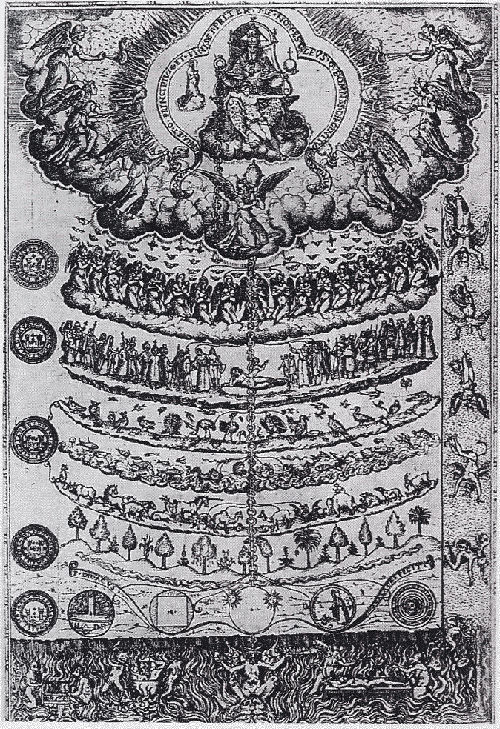
Scala Naturae – The Great Chain of Being by Diego Valadés (1579); a syncretic blend of Christian & Mesoamerican cosmogony (note cacáo tree shaded by the mother-cacáo at the very center of the arborium disc toward the base)
**********
Finally, a cold economic calculus: was Mayan money in the form of cacáo, which became Mexìcâ money, more akin to the Chinese tribute system during the Ming Dynasty (1368-1644), seeing the pochteca (or cacáo merchants) as state bureaucrats licensed to trade in an elaborate statecraft designed around power politics more than profits? If so, would that make the State especially vulnerable?
Kenneth Pomeranz & Steven Topik in The World That Trade Created have themselves created a rather novel inference about Mesoamerican commerce being extensive & well-developed but short of truly liberalizing. By the time the Spanish arrived, cacáo circulating as money was in its relative infancy, as was the notion of private property. Commerce being an extension of the state meant the pochteca were government officials whose goods they supplied were a tribute exacted thru the threat of force or the actual use of it. As such, the system became dependent on the political empire it served.
Force therefore acted as the cohesive glue that held the center together. Once the head of the Empire was decapitated, this economic (& military) theory goes, ‘the center cannot hold’ to borrow Yeats, & the whole system collapses.
Conversely, no single political center existed in the Maya lands that, once overthrown, would hasten the end of their collective resistance. Instead, the conquistadores were forced to subdue the numerous independent Maya cities one by one, many of which kept up a fierce fight until 1697.
Records document that as a unit of accounting & medium of exchange, cacáo was used for purchasing everyday goods in the markets beyond tribute to the Emperor. Sumptuary laws regulated it but only somewhat. Whether they hindered the utilization of cocoa beans as small change outside Highland Mexico where the capital was located is questionable. Whatever the public policy, the reality of the de facto private practice probably made it unenforceable.
So, a combination of both a tribute system & a commerce currency operated. Intercepting this network, & capitalizing on cacáo’s function within it, amounts to yet one node, however important, for seizing control. Marcy Norton echos this in Sacred Gifts, Profane Pleasures: “The colonizers’ immediate ability to profit from the conquest depended on their usurpation & maintenance of the tribute system organized by the Aztec rulers. Thus it was to their advantage to maintain the existing commodity production, and, in fact, cacao production expanded under Spanish rule”.
Spanish conquistadors took advantage of the Mexîcà’s cacáo trade &, in the Wall Street vernacular, they leveraged it.
Huge.
First, they raided Montecuzuma’s warehouse to purchase whatever they needed & wanted in the internal market.
Then they seized upon the accounting records kept by the Mexîcà to install their new administration. A wealth of info, these ledgers detailed a very centralized Mesoamerican society despite vast lands & diverse clans. The empire contained no private property per se – land was communal by neighborhood, commoners were tenant farmers. Certain parcels were designated royal plots, cultivated for tribute to the Emperor.
Finally, the Conquistadores set up the Encomienda upon existing systems already in place. Derived from the Spanish word “to entrust”, encomenderos or Spanish landlords never technically owned the land on which locals lived. Property remained in the possession of Amerindians. Since land was communal & the Spanish replaced the Mexîcà at the head of a central organization, privileges transferred almost wholesale where commandeering the tribute network converted to power.
Aborigines posed the key to this arrangement as much as any resources – be they cacáo, corn or otherwise – because the Spanish themselves generally loathed manual labor preferring their cocoa ala ‘Chocolate Royale’, thank you… without all the sweat, please. For that, locals came in handy, assigned to do all the work.
In addition to their “go native” strategy – interbreeding for mestizos – the encomienda system also weakened resistance to them. Strongly based on ethnic ascription, mixed-race individuals stood exempt from it. This moved many Amerindians to deliberately dilute their ancestral identity as a way to escape service, seeking intermarriage with Spaniards or Creoles. On the downside, this in turn diminished the pool of laborers. Ditto diseases ranging from small pox, influenza, & measles that decimated & demoralized the population.
Faced with this dynamic, the arrived-at solution compounded the crime, turning uglier still: the Middle Passage, a grisly slave triangle uniting African Kingship, Arab traders, & European shipping.
Inadvertently, the Conquistadores practiced a rather Eastern Martial Arts approach borrowed right from Sun-tzu: Victorious warriors win 1st & then go to war, while defeated warriors go to war 1st & then seek to win. The total combination of events & actions meant they hardly needed to fire a shot (though they certainly got off many rounds) & yet with so few men & forces they dominated an entire continent, basically half the world. As a currency throughout Mesoamerica, cacáo’s net worth proved incalculable in helping them control the internal economy then & there.
 How much direct wealth it brought in is a question literally for bean counters: accountants. To keep track of the fortune, Queen Isabella, who financed Christopher Columbus’ voyage to the Americas, founded La Casa de Contratación in 1503. Charged with enforcing the monopoly Spain sought to exert over its New World riches, La Casa controlled trade in a classic mercantilist system from its headquarters in Séville thru designated ports along the ‘Spanish Main’ – basically the coastlines of Central America & northern South America.
How much direct wealth it brought in is a question literally for bean counters: accountants. To keep track of the fortune, Queen Isabella, who financed Christopher Columbus’ voyage to the Americas, founded La Casa de Contratación in 1503. Charged with enforcing the monopoly Spain sought to exert over its New World riches, La Casa controlled trade in a classic mercantilist system from its headquarters in Séville thru designated ports along the ‘Spanish Main’ – basically the coastlines of Central America & northern South America.
La Casa de Contratación licensed all ships & captains, each requiring a clerk onboard solely to maintain detailed logs of every transaction & all goods carried. It collected all colonial taxes & duties, approved every voyage of exploration & trade, as well as administered commercial law. It kept secret information on trade routes & new discoveries, updating the highly classified Padrón Real map – a composite of many cartographers & missions, much like a Da Vinci Code or cells in an underground organization unaware of the existence, let alone movements, of other ships’ captains. The map’s Pilot Major: none other than Amerigo Vespucci, from whom America received its name. In theory, no Spaniard sailed anywhere without its approval. So restrictive, La Casa de Contratación even discouraged trade between the colonies, which afforded it to command premium prices paid by colonists for manufactured goods it sold to them. Smuggling naturally took place in such a vast enterprise… to avoid the Quinto Real (the royal 20% tax) levied on all goods entering Spain.
Because of all the black-market action, cacáo’s net worth to the Spanish Empire’s treasury may never be fully tabulated. Inestimable is probably the best guesstimate, especially when calculating that it was the means by which the Empire bought time to an even bigger ATM machine: silver… in Zacatecas (Mexico), then later & much larger in Potosi (Bolivia). Silver would become the currency for the whole emerging global economy. Even so, once those mines were tapped out, cacáo kept on giving… as both a cash crop (the Crown eventually slapped a “vice-tax” on it) & a marker of cultural ‘cool’. Just as America exports entertainment today, cacáo served as emblematic of the Spanish Empire, for in the words of Don Beto, Padrino (Godfather), Ch’ orti’ Mayan, “there’s hardly a cooler thing than cacáo”.
The combined effects of cacáo, tobacco, silver & gold so changed Spain that they infected her with ‘things Indiano’, broadened her horizons in language, culture, cuisine, wealth & power. Some would argue further how Mesoamericans avenged the Europeans with chocolate addiction & tobacco cancer – to name but 2 substances from the New World – told in the ‘Virtue on the Hill’ called Culhuacan where the goddess Coatlicue (“Serpent Skirt”) cautioned how chocolate weighs, weakens, ages & ultimately hastens death.
Perhaps so, for Spain soon reclined into lazy profligates. All the wealth inflated the economy. It delayed any diversification (which seemed utterly preposterous & unnecessary during such fabulously rich times), & retarded manufacturing on both sides of the Atlantic, failing to build any sustainable industries. After driving the Muslims from the Iberian Peninsula & destroying the Aztecs plus Incas, their conquests shifted from the battlefields to the bedrooms. In a prequel to a classic Hollywood-style studio, Spain married her way to the top of Europe – first with the Hapsburgs of Austria, followed by Bourbon France.
Still, the woes of empire overburdened her abilities to cope. While the rest of Europe underwent the Industrial Revolution, Spain frittered away its fortune as oil fiefdoms in places like Nigeria or Saudi Arabia do today. Niall Ferguson, empire scholar & financial historian, places a red-letter date at 1543 when Hapsburg Spain piled up enormous debt. By 1559, all tax revenue went to servicing interest payments on it. As early as 1576, it declared bankruptcy, broke as a church mouse lost in one of those synagogues emptied of its congregation after the Crown expelled Sephardic Jews in 1492 (ironically the same year she discovered the Americas). Piracy on the high seas, in the Caribbean & the Barbary variety on the Mediterranean continuously dogged the Spanish treasure fleet. Wars against everybody… vs. France; vs. the Ottomans (at Lepanto); vs. Brits (1588 the “invincible” Armada); The 30 Years War (1618-48); Dutch insurgency; Wars of Spanish Succession; uprisings in Peru & Chile… all topped off by plagues substantially weakened her.
By the time Napoleon invaded Spain in 1808, losing the cacáo monopoly ranked among the least of the problems.
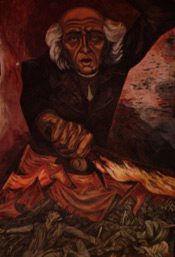 Two years later Spain lost possession of the crown jewel in its New World Empire. A rebellion precipitated a decade-long war that ended when New Spain became independent Mexico. Hatched in tertulias or salons of the upper-class who gathered over chocolate to discuss politics & issues of the day, these were the forum that excited Miguel Hidalgo Costilla, Father of the Mexican Nation, with their liberal ideas which he in turn used to recruit sympathizers into the cause. A vengeful version of Bartolomé de Casa (the Franciscan who aided Amerinds in the early days of Spanish subjugation), Hidalgo’s movement reached a climax in the famous Grito de Dolores (Cry of Pain) that incited his reckless Army of the Americas to tear thru the countryside:
Two years later Spain lost possession of the crown jewel in its New World Empire. A rebellion precipitated a decade-long war that ended when New Spain became independent Mexico. Hatched in tertulias or salons of the upper-class who gathered over chocolate to discuss politics & issues of the day, these were the forum that excited Miguel Hidalgo Costilla, Father of the Mexican Nation, with their liberal ideas which he in turn used to recruit sympathizers into the cause. A vengeful version of Bartolomé de Casa (the Franciscan who aided Amerinds in the early days of Spanish subjugation), Hidalgo’s movement reached a climax in the famous Grito de Dolores (Cry of Pain) that incited his reckless Army of the Americas to tear thru the countryside:
A new dispensation comes to us today. Will you receive it? Will you free yourselves? Will you recover the lands stolen 300 years ago from your ancestors by the hated Spaniards? We must act at once…
*******************************
The Buddha once remarked that chaos is inherent in all compound realities.Chances are, a combination of several dynamics – social, religious, political, military, & economic summed up in popular book titles along the lines of ‘God, guns, germs + division (as in ‘divide ‘n conquer’ by leveraging internal divisions) & desire (seductive forces) – intersected to bring about the outcome… that is still ongoing & unfolding.
Lest you wonder why all this appears in a Chocolate Atlas, these are seminal events that at least partially shaped cacáo into the state it is found today. For as indigenous cultures changed, so too did cacáo.
The forest of Xoconochco (Soconusco) in the southwest was then the crown jewel from where the Mexìcâ Empire sourced its best cacáo, starting with the reign of Ahuitzotl who ruled from 1486-1502 & extended the Mexìcâ (Aztec) reach down south to Soconusco – located well outside its own central territory up north (which was both arid & elevated, two factors making it difficult to grow cacáo, leaving them high & dry). Contending powers waged wars to control Xoconochco (Soconusco) because its fertile soil & humid climate produced an ideal chocolate. Around 1495 Ahuizotl wrested it away from Mam Maya – then a dominant power from the highlands of present-day Guatemala along with the K’iche’. That less than 1% of the area fell under cultivation, generating about 200 cargas (roughly 5 million cacáo beans) of tribute annually to the Mexìcâ Emperor, meant that other regions contributed substantially to his royal coffers containing up to a billion beans. Indeed, as one colonist noted “the business of the whole country is cacáo”.
Soon the Spaniards took it all over & got hooked as well. Cortés supposedly writes in a probable line of fiction attributed to him that has become a chain letter sent across the world: ‘the divine drink which builds up resistance & fights fatigue… a precious cup permits a man to walk for a whole day without food’.
Whether he actually wrote it or not, such a line does appear (in bold below) in the 1556 publication Narrative of Some Things of New Spain & of the Great City of Temestitan, México. Thought to be an eyewitness account of the conquest of the Mexìcâ / Aztec Empire, it is rumored to be written by a lieutenant to Capt. Hernán Cortés known to history only as “The Anonymous Conquistadore” (speculation points to Cortés’ mayordomo, Francisco de Terrazas). It contains one of the earliest recipes documented by a European for the preparation of chocolate learned from his Mesoamerican victims:
These seeds, which they call almonds or cacao, are ground & made into powder, & some other small seeds they have are also ground, & the powder put into ceramic vessels shaped with a spout. They then add water & stir with a spoon, & after it is well-mixed they pour it back & forth from one vessel to another until it’s foamy. The foam is gathered & put into a cup, & when they are ready to drink the beverage they agitate it with some small spoons made of gold, or silver or wood. To drink one must open the mouth wide since it has a froth so it’s necessary to make room for it to dissolve & so go in gradually. The drink is the most wholesome & substantial of any food or beverage in the world, because whoever drinks a cup of this liquor can go thru a whole day without taking anything else even if on a crosscountry journey…
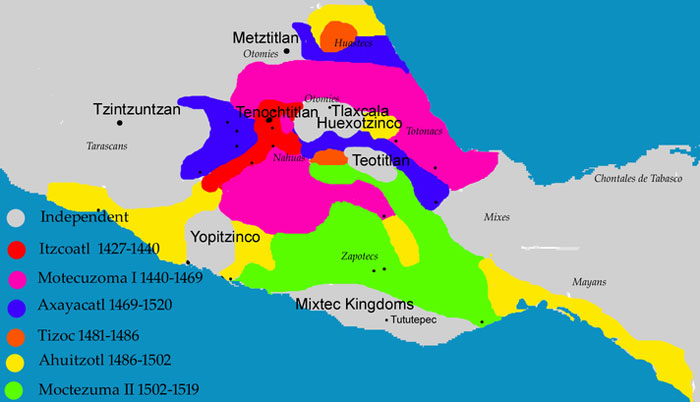
Sadly, these once thriving cacáo groves are in flux, recovering from centuries of demographic shift & disease, crop overproduction, abandonment & decay that conspired to all but wipe out Mesoamerican cacáo. Scarce premium strains of the ancient Criollo described by Francisco Hernández who recorded the first known survey of cacáo in the country (confined mostly to the Tabasco area between 1571 & 1576), have all but vanished. He noted cacáo fruits in a range of 4 primary varieties, generalized as oblong, ridged & red. Friar Alonso Ponce’s visit to Soconusco around 1586 mentions 2 types, dispelling myths about a uniform single variety.
Between 1600 & 1620 the Province of Caracas (Venezuela) sold cocoa destined for the port of Veracruz, Mexico to indigenous costumers there, a sign of just how depleted the once grand cacáo groves of Mesoamerica had fallen. The trade for it was also lucrative across the Caribbean & kept Caracas as a lynchpin in the economy of the Viceroyalty of New Spain.
The accounts from Martinez in 1912 to Soria in 1961 saw perhaps the greatest change. During that half-century, Criollo was replaced by hybrids of Amazon Amelonado & Calabacillo lineage, notably the Matina type brought up from Costa Rica, assuming the name Ceylan. Plants from Ecuador were also introduced. In the 1970s the government promoted breeding programs that further eroded Criollo stocks… a generalized móle of a genetic mix known as Injerto, literally ‘grafts’ but more accurately ‘scions’. The majority of these crops are currently controlled by the industrial giants Ibarra & Mayordomo operating in Tabasco, Chiapas, & Oaxaca.
Problematic reports continue to circulate of high-performing old Criollo thriving as ornamentals in the backyard “kitchen gardens” around Xoconochco (Soconusco) on Mexico’s southwest Pacific Coast. Ditto the semi-wild inland stands way to the northeast around the forested Rio Usumacinta basin, an area rife with Mayan archeological sites. Lack of genetic diversity & palynological evidence [pollen/spores] mitigates against any ‘wild’ claims according to geneticist Dr. Juan Carlos Motamayor, a view at odds however with University of Vera Cruz professors Ogata & Gómez-Pompa. In any case, consider them unsullied by development. Cacáo trees originally would’ve been planted here in pre-Columbian times to supply those Mayan ceremonial centers. Among the region’s current inhabitants are the Lacandón, a splinter group of Mayans who continue to resist the Federales in Mexico City today.
The interaction of several Mayan bands who came together in the 18th century to make common cause while escaping Spanish colonial rule, the Lacandón were a wave of runaways, the last of the true Mesos (perhaps why they call themselves Hach Winik – “Real People” – as opposed to all other “unreal humans”). They share solidarity with Jamaican Maroons & the Afro-Ecuadorians around Esmeraldas enduring a similar experience. Free to live independently in the inaccessible forest redoubts beyond the reach of colonials, Lacandón conceived new traditions that temporarily resisted change. The rugged terrain & thick forests acted as a barrier against the wider world, discouraging outsiders from venturing in. Their isolation became a preserve for their identity. As a result the Lacandón were never completely “conquered” in the classical sense.
That geography also fostered Milpa agriculture, the likely method under which cacáo had earlier flourished to reach its zenith during the first millennium at the very center of its domestication. Shallow soil deposits, limited rainfall & canopy cover encouraged a variety of intensive agricultural techniques among ancient Mayan. Methods ranged from canals, terracing, raised fields, fecal fertilizer, seasonal swamps, dikes, dams, hydraulics, & swidden systems.
Swidden, or ‘slash ‘n burn’, to cite one example, clears & temporarily fertilizes the area to be cultivated. The resulting ash raises the soil’s pH, which in turn increases soil nutrients, especially phosphorous. A planting cycle repeated every 2 to 5 years complements it, at which time land would be replenished with trees & wild plants (a phase-zone referred to as acahual).
Little by little, contact with the outside world influenced the Lacandón’s insular environment. The more they had with it, the more they morphed, specifically their attraction to modern tools. They traded cacáo among other goods for them.
Soon this gradual exposure led the outside world to come crashing & cashing-in for the region’s assets. A common refrain found in rainforests all around the equator: mining, logging, oil, etc. Migratory chaos ensued among forest dwellers that gave the Federales an opportunity to exert their authority on the heels of commercial interests.
To reshuffle migration patterns the government decreed in the early 1970s a large part of the forest in Chiapas (614,000 hectares) the protected Montes Azules Biosphere Reserve. It granted one small group of 66 families all the territory in the Biosphere, declaring them the authentic “Lacandón Community”, whereby some 2,000 Tzeltal & Chol families from a couple dozen locales inside it were uprooted & forcibly displaced to other areas, leaving everyone dependent on Mexico City for land rights & deeds.
In the decades that followed the Federales carried out numerous programs to keep problems under control, using land distribution as a political tool, as a way of ensuring loyalty from different campesino groups, part of a populist agrarian reform that almost mimics a zoological experiment: ‘let’s set them free in the wild & see if the Lacandón survive for future ethno-botanic research while we engineer social programming with these others’. The strategy of ‘divide ‘n rule’ led to disaffection, then conflict, & put further pressure on a rainforest ecology already reeling so by the 21st century two-thirds of the entire jungle had been cut down for pasture & crops to the dismay of horticulturalist Gertrude Blom – one of the Lacandón’s most ardent & vocal sponsors.
Its gradual disappearance revealed numerous God Houses that some communities had secreted away in the jungle, quite remote from village life, hidden from outsiders. In such a sacred space the felling of timber & cutting of vegetation were once strictly prohibited (hence, unlikely for any companies to get their commercial hands on heirloom cacáo). Among the blessed objects found scattered about are God Pots for incense &/or offerings – small ceramic bowls, usually adorned with the full-featured head of the deity they represent attached to the rim. Pots come alive during ritual use, ensouled (pixan) with the essence from incense smoke, centered by placing sacred stones from Maya ruins, & given heart with cacáo seeds. The ancient practice of reddening with achiote so the whole admixture cumulatively presents a form of “burning blood” symbolizes sacrifice that the gods “consume” for nourishment in order to maintain balance in the universe.
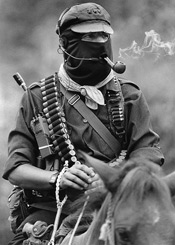 Into this fraying environment, this socio-political morass, stepped scads of missionaries & Maoists, int’l activists & NGOs, from cosmopolitan capitals around the world, agitating for revolution, or a lighter variant like liberation theology, plus a handful of other social theories. Most carried vaguely diffuse portfolios of discontent like anti-neoliberalists raging against the machinery of globalism. The seldom-known enclave of Chiapas rose to the top hotspot project for those hoping to score one for “people power”, kept alive by a romance of a happy primitivism, spiritually pure, & well connected to the forest & the cosmos (even if few actually cared to live that way). Leading the parade was Subcomandante Marcos – a Quixote-sized character of his own, with Subcomandante Ramon his female Panza – of the EZLN (Zapatista Army of Nat’l Liberation) who waited patiently for the right moment to trigger their insurgency. On the very day NAFTA went into effect, 1/1/94, the EZLN floated its IPO: an armed rebellion directed against the marginalization of Amerinds seeking greater rights. The next 15 years brought a lot of attention to them, & with it change.
Into this fraying environment, this socio-political morass, stepped scads of missionaries & Maoists, int’l activists & NGOs, from cosmopolitan capitals around the world, agitating for revolution, or a lighter variant like liberation theology, plus a handful of other social theories. Most carried vaguely diffuse portfolios of discontent like anti-neoliberalists raging against the machinery of globalism. The seldom-known enclave of Chiapas rose to the top hotspot project for those hoping to score one for “people power”, kept alive by a romance of a happy primitivism, spiritually pure, & well connected to the forest & the cosmos (even if few actually cared to live that way). Leading the parade was Subcomandante Marcos – a Quixote-sized character of his own, with Subcomandante Ramon his female Panza – of the EZLN (Zapatista Army of Nat’l Liberation) who waited patiently for the right moment to trigger their insurgency. On the very day NAFTA went into effect, 1/1/94, the EZLN floated its IPO: an armed rebellion directed against the marginalization of Amerinds seeking greater rights. The next 15 years brought a lot of attention to them, & with it change.
Whatever their faults, the EZLN eventually laid down weapons in favor of a tactical media offensive. They forged disparate factions together into a strange coalition of libertarian-socialism / Anarcho-Chomskyites that enacted Participatory Democracy in several autonomous municipalities throughout Chiapas. These Juntas de Buen Gobierno established independent educational & healthcare systems, with their own schools & hospitals in places otherwise neglected by the government, making them kin to the better features of Hamas in Gaza & Hezbollah in Lebanon.
Today, commercial production of inanimate God Pots (absent any blood, heart ‘n soul) draws tourists like magnets. They even appear in the terminals of “airport arts”. Part of the end stage to a disappearing act: whatever residuals are left over, market them, even if it includes marketing ethnicity itself as a commodity trinket.
And quick.
For the death of elders, & their youth spurning the ancient wisdoms in favor of the cash economy, often means traditions are irretrievably lost because they aren’t passed on to the next generation. Many instead convert to Christianity. Add in TV, the internet, cell phones & Lacandón might as well be LA or London minus the concrete.
Searching for the true “authentic Lacandón” nowadays takes on a wild goose chase under the well-intentioned banner of helping them find themselves. Such campaigns seldom work & usually lead to discord. They aggravate the problem by either imposing or filtering a view that no longer exists for preserving an identity in pristine form is impossible.
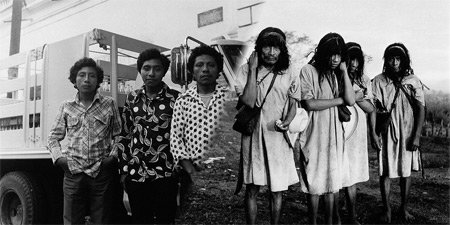 Coming & Going Every Now & Then: “When Indians wear gringo clothes… the end will come.” – Frans Blom (photos by Gertrude Blom; left – Lacanja, San Cristobal de las Casas, 1979; right – Monte Libano, El Real, 1959)
Coming & Going Every Now & Then: “When Indians wear gringo clothes… the end will come.” – Frans Blom (photos by Gertrude Blom; left – Lacanja, San Cristobal de las Casas, 1979; right – Monte Libano, El Real, 1959)
A tale told worldwide writ small: the ongoing centuries-long saga of Theobroma cacao, particularly in its New World birthplace, parallels to a large degree the story of cultural survival of indigenes, some of whom still continue to cultivate it to this day.
Cacáo here supposedly bears striking resemblance to the Peñon in Colombia’s Sierra Neveda de Santa Marta, suggesting a possible link, doubly so when coupled with growing evidence that both ancient peoples prepared their cacáo beverages similarly. Speculation centers around the isthmus as the meeting ground for Meso- & South American cultures, perhaps exchanging the ancient Grand Criollo (see Costa Rica).
These Lacandón trees may be relics of the past that hold keys to cacáo’s future. López-Baez in 1989, reconfirmed by Evans a decade later, observed a low density of them scattered about in isolated pockets of variability, growing under forest shade, each marked by inbred homogeneity. They belong superficially to the Criollo family, possibly traditional Mesoamerican cacáo (even as they differ from the classic Pentagonum type along the Pacific Coast zone), with characteristic thin husk & though small in size they seem to be doing well enough to evolve for generations, maybe even centuries. Could they be descendants of what Hernández surveyed in the 1500s – the aboriginal Criollo – including the pre-Hispanico Tlalacacáhoatl whose tiny pods were roughly the size of a jumbo egg? Perhaps this cacáo, in a twist of poetic & social justice, possesses the inherent survival strategies to solve the riddle plaguing the entire species.
S.O.S. because Chiapas’ cocoa production slumped by half starting in 2005 at the hands of the Moniliasis blight. By Summer 2013 Hershey’s stepped in along with the Ecom Cocoa Group to “restore” yield levels. Their multi-million dollar plan calls for nurseries to grow disease-resistant strains for widespread distribution throughout the area. Will this repeat the Hummingbird disaster in Belize or become a genuine restoration of Mesoamerica’s cacáo nobility?
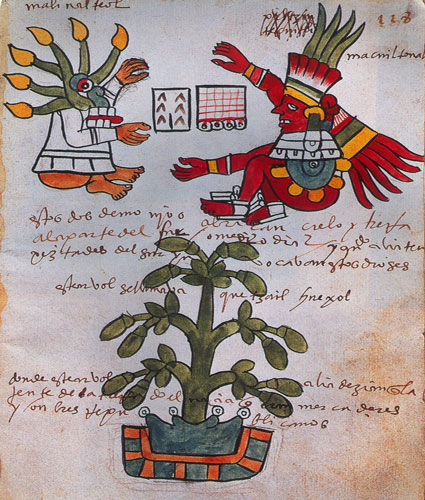
Mexìcâ (Aztec) manual for cultivating cacáo





